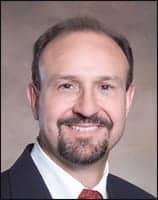By being visible, proactive, and creative, the biomed team at Dayton Children’s Medical Center has earned recognition and respect.
Customized transportation systems, video-game-console mounts, and one-of-a-kind toys—these are just a few of the innovative solutions that the biomeds at Dayton Children’s Medical Center (Dayton, Ohio) have created to bridge the gap between what they need and what is available in the marketplace. In part because of this willingness to make or customize products to benefit patients, the biomedical engineering group within this 155-bed teaching hospital, affiliated with Wright State University (Dayton, Ohio), is highly esteemed and has garnered for itself a well-deserved seat at the medical center’s leadership table.
 The Dayton Children’s biomed department, shown in one of the hospital’s new surgery rooms, was instrumental in the installation of an integrated endoscopy system, which is mounted to a pivoting headwall.
The Dayton Children’s biomed department, shown in one of the hospital’s new surgery rooms, was instrumental in the installation of an integrated endoscopy system, which is mounted to a pivoting headwall.
“We provide a lot of value to the hospital, even though we’re a small department. One of our most important contributions is in the area of capital equipment planning. At capital budget time, we’re asked for our opinions and recommendations based on the knowledge we possess about equipment reliability, service histories, and cost trends. We’re also called on from time to time to help clinical departments plan out the design of the care units they want to build or remodel,” says Steven Tomlin, CBET, biomed group leader.
“Our contributions to the success of the mission of this hospital are recognized and appreciated,” says David Starkey, CBET, environment of care manager, who oversees the biomed department and several other departments.
Going the Extra Mile
Along with Starkey and Tomlin, the biomed team at Dayton Children’s consists of technicians Dale Smith, BMET, and Neil Diehl, BMET. Starkey concentrates on the management end of things, while the other three tend to the maintenance and repair work. However, Tomlin, Smith, and Diehl are each specialized in one or another category of equipment repair.
 The Dayton Children’s biomed team, pictured left to right, Neil Diehl, BMET, David Starkey, CBET, Steve Tomlin, CBET, and Dale Smith, BMET.
The Dayton Children’s biomed team, pictured left to right, Neil Diehl, BMET, David Starkey, CBET, Steve Tomlin, CBET, and Dale Smith, BMET.
“We wanted our techs to become really good at what they do, so we assigned them to become experts in different areas,” Starkey says.
At the same time, the department insisted the techs also develop a certain amount of skill as generalists in order to be capable of filling in whenever the designated specialist is unavailable.
“We think some degree of skill overlap is important, because there will always be times when the tech who should be assigned to take a service call is busy elsewhere, is out sick, or is away on vacation. Without overlap, we can’t fulfill our pledge to respond quickly to calls, especially if it’s concerning a critical system,” Tomlin says.
Located on the lower level of the 500,000-square-foot hospital, the biomed department operates weekdays from 7:30 am to 4 pm, with one tech always on call throughout the night and around the clock on weekends. In the span of a year, the department conducts upward of 4,000 preventive maintenance inspections and about 1,000 repairs.
A source of pride for the department is its ability to satisfy challenging requests from other departments. “We go the extra mile, no doubt about it,” Starkey says.
The department demonstrates its willingness to go that extra mile by daily walking the literal equivalent of one. For a number of years now, the techs have made rounds in the hospital first thing every morning. “We don’t sit around and wait for the phone to ring,” Tomlin says. “At the start of the day, we fan out across the enterprise and check to see if anybody has any problems or concerns they want to report. We also have designated pickup spots where the various departments can leave broken equipment for us if it involves nonurgent repair.”
One-On-One
Making rounds has proven extremely beneficial to the department’s relationships with others. “It’s a way for us to establish and build rapport with key people in all the clinical areas,” Tomlin explains. “Sure, we could be anonymous and keep to ourselves in the basement all day. But we feel that having one-on-one relationships helps us better serve the various departments so that they can function more smoothly and successfully.”
It is a two-way street, as it turns out: The interdepartmental relationship-building strategy also allows the biomed department to function more efficiently and successfully. Says Starkey, “The comfortableness of the friendships we’ve established results in clinicians giving us more complete and accurate information about equipment problems, which makes it easier for us to solve the problem. Problems are not always hardware- or software-related; often, they have to do with the way clinicians operate the system. If by talking to our key contacts we’re able to determine that a problem is due to operator error, we avoid going through the time and trouble of tearing down the equipment in search of a problem that’s not there.
“Instead,” Starkey continues, “what we can do is arrange to provide targeted in-servicing to help that particular clinician—and any others in that department who are making the same mistakes—be able to properly use the equipment and obtain the best results when they do.”
In recent years, the biomed department has ramped up its in-servicing efforts all around. “Because we’re out there, we see what’s going on globally,” Tomlin says. “We see the repetitive errors being made with the way equipment is operated. Consequently, we’re uniquely positioned to promote enterprise-wide quality improvements.”
The hospital concurs in that assessment, as evidenced by the fact that the biomed department’s instructional support is now part of the orientation training given to newly hired clinicians in every department.
Starkey’s department gauges the effectiveness of its in-servicing by analyzing the work orders it subsequently receives. If four of those orders in any given quarter are the result of the same type of operator error in the same clinical area, then it knows it needs to deliver more in-servicing to that department’s staff.
Meanwhile, interdepartmental in-servicing represents a return to its roots for the biomed department. Decades ago, the biomed team served as the hospital’s default instructors pertaining to equipment operation, a role it gradually ceded over the years to the then-newly developing clinical education department. But now, with equipment more sophisticated than ever, the specialized expertise of the biomeds is once more needed to help users fully understand the technologies they are operating, according to Starkey.
Made To Order
The biomedical engineering department earns plaudits in other ways besides making rounds and in-servicing. For instance, when there is a need for a product, but no product is commercially available for the purpose, the biomed department will ride to the rescue—either by attempting to modify a product that comes somewhat close to filling the bill, or, failing that, by making a suitable product from scratch.
A good example of how this plays out comes from the time the hospital’s transport team sought the biomed department’s help in searching the marketplace for a pediatric transporter with certain unconventional attributes. Alas, nothing with the exact combination of desired features and capabilities could be found.
“This transpired back around the mid-1990s,” Starkey says. “The only systems that were available didn’t work very well for our intended purposes. None of them provided a good platform for carrying an incubator, battery packs, and oxygen cylinders.”
Worse, the choice of systems tended to be unacceptably bulky and heavy. “The only way we could have gotten any of them into our ambulances was by outfitting the ambulances with a ramp or a powered lift,” Starkey continues. “That would have been a very expensive way to go, not to mention impractical. So we brainstormed and spent a lot of hours in front of a dry-erasable whiteboard putting up our ideas, sifting through them, tossing the ones that were unworkable, and building on the ones that were good.”
Eventually, the biomed team arrived at a concept for a frame add-on system that offered exactly the platform features and functions the transport team wanted. The finished product—essentially a lightweight aluminum sled that glides into place atop a one-man, easy-fold, largely unmodified transporter cot—was designed to accept a neonatal incubator and its battery. The sled included cushioned holders on one end for a pair of oxygen cylinders and for another pair of compressed-air tanks. Also featured were special mounts for infusion pumps so that the devices could sit directly on the transporter rather than be carried on maneuverability-restricting stanchions. Along the length of the platform were holders onto which boxes of supplies could be latched, and there were compartments for the stowage of medical bags.
“We tried to create a system that would allow the transport team to carry everything they told us they might possibly need to take with them on an ambulance ride,” Starkey says, confessing that the department cannot take all the credit for this project. “The parts that needed to be assembled to form the basic frame were cut and welded for us by an outside fabrication shop from technical drawings prepared by Steve. At the time, the hospital didn’t have nearly as much metalworking equipment and talent as it does now.”
Notably, the transporter-sled project entailed little in the way of prototyping to arrive at a final, acceptable design. “It’s the same for anything we make,” Starkey says. “Before we send a project out for fabrication, we will have looked at it a thousand different ways to get it right.”
Since building that first sled, the department has manufactured two more like it and currently has a fourth in production.
Adaptable Model
Another homegrown solution crafted by this team, when a satisfactory commercially made product could not be procured, had to do with keeping patients entertained.
“We came up with a system to mount a PlayStation® 2 on some of the older children’s headwalls so that they could play video games and watch DVDs,” Tomlin says. “The design of these mounting systems had to be secure, functional, easy to use, and aesthetically pleasing.”
When word of the PlayStation mount spread to other hospitals in the area, those facilities asked the biomed department if it planned to market the headwall accessory. The answer was no. “We thought about it a bit and then decided the right thing to do was not make up a bunch of these mounts, put our label on them, and start selling them, but, rather, just give to each interested hospital a copy of our design schematics and let them build their own,” Tomlin says.
Tomlin thinks other hospitals’ biomed departments across the country could also just as easily duplicate the entire Dayton Children’s Medical Center approach to biomedical engineering.
“If you want to be recognized for the important service you provide, the first thing you’ve got to do is be visible,” he says. “The second thing is be proactive. And the third thing is be creative. Do all that, and there is every likelihood you’ll end up an even more integral element of your organization’s success story than you could have possibly imagined.” 24×7
Rich Smith is a contributing writer for 24×7.




